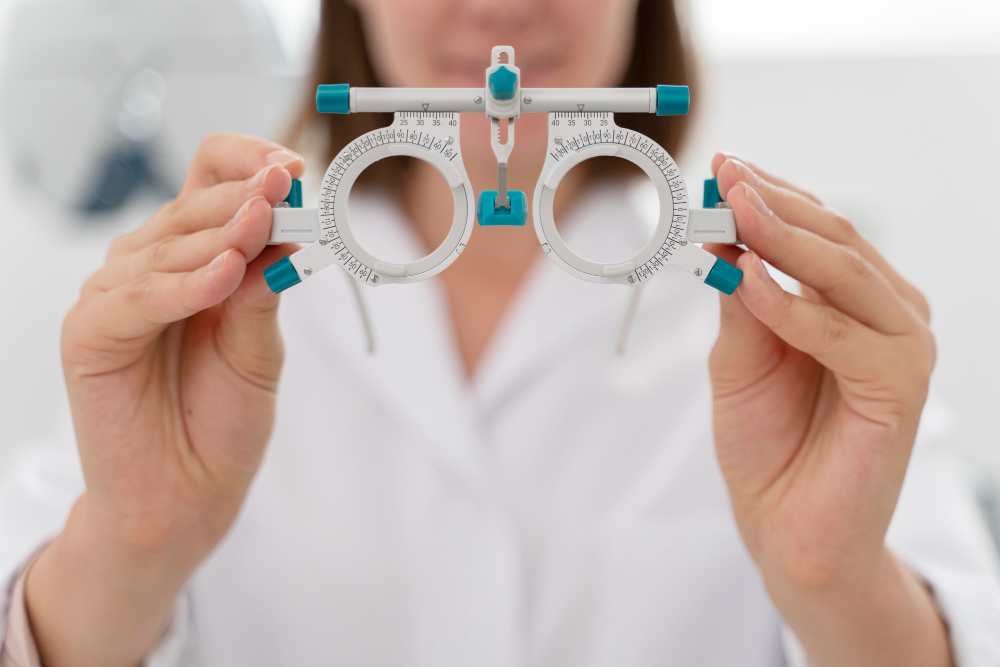Ophthalmology Treatments

Myopia
Description: Myopia, or nearsightedness, is a condition where distant objects appear blurry.
Treatment: Treatments include corrective lenses (glasses or contact lenses), orthokeratology, and refractive surgeries like LASIK.
Hyperopia
Description: Hyperopia, or farsightedness, causes difficulty in seeing close objects clearly.
Treatment: Treatments involve prescription glasses or contact lenses and refractive surgery options like LASIK or PRK.
Astigmatism
Description: Astigmatism is caused by an irregular curvature of the cornea or lens, resulting in blurred vision.
Treatment: Corrective measures include glasses, contact lenses, and refractive surgery such as LASIK or toric lens implants.
Presbyopia
Description: Presbyopia is the age-related loss of near focusing ability, typically occurring in middle age.
Treatment: Reading glasses, bifocals, multifocal contact lenses, and surgical options like lens implants are used for treatment.
Cataracts
Description: Cataracts involve the clouding of the eye’s natural lens, leading to diminished vision.
Treatment: The primary treatment is surgical removal of the cloudy lens, replaced with an artificial intraocular lens (IOL).
Glaucoma
Description: Glaucoma is a group of eye conditions that damage the optic nerve, often due to high intraocular pressure.
Treatment: Treatments include eye drops, oral medications, laser therapy, and surgical procedures to lower eye pressure.
Macular Degeneration (AMD)
Description: AMD is a degenerative condition affecting the central part of the retina, leading to vision loss.
Treatment: Treatments involve lifestyle changes, anti-VEGF injections, laser therapy, and nutritional supplements.
Diabetic Retinopathy
Description: Diabetic retinopathy is a complication of diabetes that damages the blood vessels in the retina.
Treatment: Treatments include laser surgery, vitrectomy, and injections of anti-VEGF drugs to reduce swelling and prevent new blood vessels from forming.
Retinal Detachment
Description: Retinal detachment occurs when the retina peels away from its underlying layer, causing vision loss.
Treatment: Surgical options include laser therapy, cryopexy, pneumatic retinopexy, scleral buckling, and vitrectomy.
Conjunctivitis (Pink Eye)
Description: Conjunctivitis is inflammation of the conjunctiva, often due to infection or allergies.
Treatment: Treatment depends on the cause and may include antibiotics for bacterial infections, antihistamines for allergies, and proper hygiene practices.
Dry Eye Syndrome
Description: Dry Eye Syndrome is characterized by insufficient tear production or poor tear quality, leading to eye discomfort.
Treatment: Treatments include artificial tears, prescription eye drops, punctal plugs, and lifestyle modifications.
Keratitis
Description: Keratitis is inflammation of the cornea, typically caused by infection or injury.
Treatment: Depending on the cause, treatments include antimicrobial eye drops, antiviral medications, and sometimes corticosteroids.
Strabismus
Description: Strabismus is a condition where the eyes do not align properly, leading to double vision or amblyopia.
Treatment: Treatments include corrective glasses, eye exercises, prism lenses, and surgical correction of eye muscles.
Amblyopia (Lazy Eye)
Description: Amblyopia, or lazy eye, results from the brain favoring one eye over the other, leading to reduced vision in the affected eye.
Treatment: Treatments include patching the stronger eye, atropine drops, vision therapy, and corrective glasses.
Ptosis
Description: Ptosis is the drooping of the upper eyelid, which can obstruct vision.
Treatment: Treatment often involves surgical correction to lift the drooping eyelid.
Blepharitis
Description: Blepharitis is inflammation of the eyelid margins, leading to red, itchy, and swollen eyelids.
Treatment: Treatments include good eyelid hygiene, warm compresses, antibiotic ointments, and sometimes oral antibiotics.
Uveitis
Description: Uveitis is inflammation of the uvea, the middle layer of the eye, causing pain and vision problems.
Treatment: Treatments include corticosteroid eye drops, oral steroids, immunosuppressive drugs, and addressing underlying conditions.
Corneal Ulcers
Description: Corneal ulcers are open sores on the cornea, often due to infection or injury.
Treatment: Treatment typically involves antibiotic, antifungal, or antiviral eye drops, and in severe cases, corneal transplantation.
Retinitis Pigmentosa
Description: Retinitis Pigmentosa is a genetic disorder causing progressive degeneration of the retina.
Treatment: While there is no cure, treatments focus on managing symptoms with vision aids, vitamin A supplementation, and retinal implants.
Nystagmus
Description: Nystagmus is characterized by involuntary, rapid, and repetitive eye movements.
Treatment: Treatments may include glasses, contact lenses, medications, vision therapy, and in some cases, surgery to reduce eye movement.
Color Blindness
Description: Color blindness is the inability to distinguish certain colors, typically due to genetic factors.
Treatment: While there is no cure, special lenses and visual aids can help individuals differentiate colors better.
Conjunctival Disorders
Description: Conjunctival disorders encompass various conditions affecting the conjunctiva, such as inflammation, infection, and tumors.
Treatment: Treatments depend on the specific disorder and may include medications, surgical excision, and proper eye hygiene.

